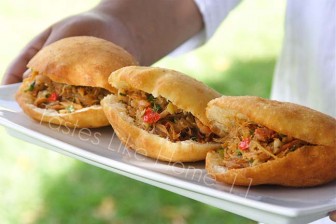Hi Everyone, on the morning of Wednesday, November 21, 2007, I received an email from an avid reader of this column and my blog. There was a one-line paragraph that stood out:
“To those who sometimes question whether there is such as thing as the Guyanese identity, I can now point them in the direction of your column and website.”

This month marks the beginning of the fifth year of the Tastes Like Home column. It is by pure design of the heavens that the release of the book coincides with this anniversary. Oh my, five years, can you believe that you and I have been talking for so long? I know I do most of the talking and you the listening. (Smile). Tastes Like Home started off as a way for me to chronicle the foods of Guyana that I missed and share with you my thoughts and memories of those foods. Along the way, I quickly realized that I was not just talking about the food of Guyana but the food of the region. For most part, the English-speaking Caribbean.

Long before the trendy term “fusion cuisine” came into being, we were cooking a fused cuisine. In the Caribbean we can boast of African, Indian, Indigenous, English, Spanish, Chinese, French and Middle Eastern food influences. Those influences extend to not just ingredients but also to techniques and methods of preparing food. Our ancestors brought their food ways to the region; all of them, those forced and those fooled. They quickly adapted and made good use of what was available; creating new dishes and twists or versions of the food they made back in their homeland. As Caribbean people, the trait of “making do” is something we have perfected. That is why we can rarely go hungry because we can take a little and make it into something that we can share with others.
In my book, I set out to show that Caribbean food is much more than a garnish. Too often, it seemed to me, when non-Caribbean people wrote of Caribbean food, they were content to drop a slice of pineapple or mango on the side of the plate and call that Caribbean food. Yeah right!
I wanted to show the rich diversity of our food culture and, by writing about those foods in context, I hoped I’d remind us and show others about the diversity and the interconnectedness of Caribbean identities.
For example, bakes are delicious fried dough that we make in all forms and shapes up and down the Caribbean and we eat it with what? Fried salt fish of course! And if you’re ever in Trinidad and Tobago, have it with fried shark and lots of that chadon beni sauce.
Ground Provisions – oil down, run down, mettagee, call it by whatever name you wish depending on which country you are in. There is nothing quite as comforting as some melting cassava, fluffy dumplings, sweet ripe plantains and sweet potatoes, cooked in fresh coconut milk. Top that off with some fried salt fish or fried fish and you’re good to go for a long time. All you’ll need after is a hammock and some breeze.
Conkies – from Suriname in the south to Antigua in the north, you can find a version of conkies. So too can you find curry. Don’t think that it is only in Guyana, Trinidad or Jamaica that you can get outstanding curry. One of the best curries I had outside these three countries was in St Vincent and the Grenadines. And don’t go looking in the hotel restaurants for the curry, try the smaller eating establishments.
Golden Apple aka June Plum, takes a place of prominence in the book by showing its diversity, it can be stewed, it can be made into a drink and I even made a golden apple crumble!
Vegetables are a-plenty and goodness, gracious, we do know how to cook vegetables in the Caribbean. And finally before I go, what would a book about Caribbean food be without the number one condiment – pepper sauce!
I’ve just mentioned a few of the items in the book that you can find all across the Caribbean in different versions and variations. The bottom line is, is that it shows that we have a cuisine, Caribbean cuisine. And it tastes GOOD!
I hope that you enjoy the book because it is yours. While for the past 5 years I may have been doing most of the talking, I have been listening too, to your comments, your advice and your suggestions. I offer you my heartfelt thanks. Your support and encouragement have been motivating and inspiring and your input will continue to inform my work.
Books are available at Austin’s Bookstore on Church Street.
Cynthia





